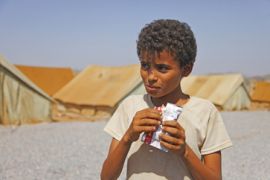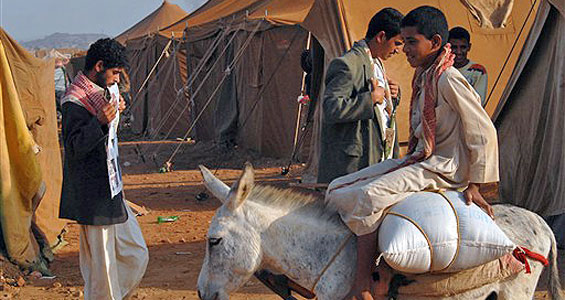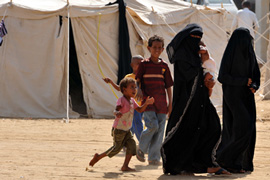Food aid shortfall threatens Yemen
Thousands face hunger as funding for assistance programmes dries up.

 |
| Thousands of displaced Yemenis who escaped fighting in the northern Saada province relied on United Nations assistance programmes for food and tent shelters [AFP] |
At a UN-sponsored distribution centre in Thulla, a picturesque but dirt poor village 50km north-west of Sanaa, 30-year-old Jamila Ali al-Mohn gathered with a few dozen pregnant women and young mothers to collect a two-month support bag of grain, oil, sugar and salt.
The distribution of such food necessities is the culmination of an effort by the World Food Programme (WPF) working in tandem with the Yemeni health ministry to ensure these pregnant women and young mothers have enough to feed themselves and their babies.
“We haven’t eaten meat for a year. If there is money, I go and buy eggs and vegetables from the market, but other than that all we have is bread and tea,” said Jamila, a mother of four.
Her husband was at work, the first day’s labour he had seen on the farm for two months, she said.
When there is no farming to be done, he travels to Sanaa with a bundle of narcotic qat leaves to sell to the many addicts of the city. All together he makes around $30 a week.
But al-Mohn and other needy Yemenis may soon find that they will have to look elsewhere for food assistance as the WFP says it may no longer be able to continue aid deliveries.
Lack of funding
| in depth | |||||||||||||
|
As the international community focuses on defeating al-Qaeda in Yemen, millions of ordinary people in the country on the south-west tip of the Arabian Peninsula are quietly starving as vital deliveries of UN food aid are severely cut due to a lack of funding.
By the end of June 2010, analysts predict, the WPF will have no food to distribute to Yemen’s millions of hungry.
There are fears that this will debilitate the nearly one in three Yemenis – over seven million people – who struggle daily to find enough food to live a healthy and productive life, leading to rates of malnutrition that are the third highest in the world.
A recent survey by the WFP estimated that of those going hungry each day, 2.7mn Yemenis are classified as “severely food insecure” meaning they spend one third of their meagre incomes just on bread.
“They are in a total poverty trap,” says Gian Carlo Cirri, thw WFP country director.
“Most of the time they are illiterate, they have no access to land or water. The children are not attending school and the probability of having a malnourished child in the family is extremely high.”
Dangerous journey
WFP estimates it requires $103m this year and next in order to feed over three million of Yemen’s poor and hungry, including up to 350,000 people displaced by the recent war in the north and the boatloads of Somali refugees continuing to pour into the country.
There are fears that a sudden cut in food aid to those displaced people living in camps such as Mazrak could spur families to return to areas in and around Saada, damaged by the sixth round of war between the army and Huthi rebels, before they have been properly cleared of unexploded ordnance and mines.
Already local reports say at least 20 people have been killed or injured after triggering booby traps left over from the war.
So far this year WFP has received just one donation from the US consisting of food and cooking oil worth $4.8mn. According to Cirri, the US donation equals the $4.8mn internal loan the agency was forced to take out to continue its operations until the end of June.
A further $3mn to WFP from the UN Central Emergency Response Fund is due to be received by the end of the month, but will do little more than cover the needs of refugees.
Traditional donors to WFP Yemen, including Germany, Saudi Arabia and Britain, have yet to pledge assistance, a move seen by some observers as reluctance to write blank cheques for the government of Abdullah Ali Saleh, the Yemeni president, without seeing concrete political and security reforms that would help ease his country’s acute instability.
“Donors are still two years behind the humanitarian community. Politics is irrelevant in a humanitarian situation. Feeding people is a moral issue,” said Andrew Moore, head of Save the Children in Yemen.
Foreign investment
 |
| Recent fighting in the north displaced thousands of Yemenis [AFP] |
A meeting at the end of March in Abu Dhabi brought together Yemen’s Gulf neighbours and Western countries, building on January’s discussions in London on how to spend the $5.7bn of investment pledged in 2006, but of which to date less than 10 per cent has been disbursed.
Most of the shortfall has come from the at least $3.7bn of assistance pledged to Yemen by the six-member Gulf Cooperation Council (GCC).
Yemen’s Deputy Planning Minister Hisham Sharaf Abdullah presented the ‘Friends of Yemen’ meeting with a five-year development plan which he said would need $44bn in funding.
Yemen has long suffered the neglect of the international community: In 2006 the country received just $13 per person of Overseas Development Assistance (ODA), about one-third of the average for Least Developed Countries.
The UN’s first ever humanitarian appeal for Yemen, launch in December and totalling $177mn, was, as of late last month, 80 per cent under-funded.
The massive humanitarian intervention in Haiti, which has received pledges of $9.9bn – more than double the amount requested by the Haitian government – is known to have had a direct negative impact on relief aid to Yemen.
“On the edge”
Meanwhile, the ‘Triple F crisis’ – rising food prices, falling fuel revenues, and cuts to remittance flows due to the financial crisis – has increased poverty here by nearly 25 per cent since 2006, wiping out decades of development.
“People are really on the edge. The slightest shock will put their lives in danger,” said WFP’s Cirri.
The United Nations High Commissioner for Refugees (UNHCR), the lead agency providing shelter to Yemen’s refugees and displaced, has less than one-fifth of its required $39m budget, according to spokesman Andrew Knight. “It is crucial we receive funding soon. The humanitarian needs are huge and growing,” he said.
UNHCR has submitted funding proposals to Gulf states including Saudi Arabia, Qatar and the UAE.
The agency is now applying for its third internal loan of up to $4mn this year in order to continue providing tents and services, a situation which Nabil Othman, the deputy representative, said was unprecedented in the 20 years he had worked for UNHCR in Yemen.
“Some donors believe the GCC can contribute more and we have to hope we see a positive response in the near future,” said Othman.
UNICEF, the UN fund for children, is likewise struggling to meet basic needs. Yemen has the lowest average birth weights in the world, according to Dr Kamal Ben Abdullah, the head of the Young Child Survival and Development project at UNICEF Yemen.
While its regular development programme remains well-funded, UNICEF’s appeal for emergency projects such as feeding thousands of severely malnourished children, those who are in immediate danger of starving to death, remain substantially under-funded.
